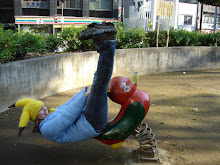Point and dereference,
Then index, convert, and print.
What am I doing?
It's been a shockingly productive day here in Bloomington. I finished up that OS assignment, wrote some proofs for analysis (which I am still not a fan of... hand-waving gets my goat, and we don't seem to have formal definitions for half the things we are trying to prove statements about), baked a pizza (dericious... recipe below), worked through most of the packet-sniffer for networks, practised piano, and bathed. Crazy, I know.
Ok, elaborations, for those of you still reading:
Analysis: So the prof for this class is a topologist who is teaching analysis. If you are unfamiliar with these words, it's not really important to know what they mean, just that that is a very weird thing. Those fields are, while not diametrically opposed, quite dissimilar in focus. This leads to the prof sometimes deciding that we don't know and don't need to know something, whereupon he promptly draws a picture, waves his hands, says some semi-meaningful things, and moves on. It can lead to very frustrating homework sessions with Chas where we realise that we have no idea what we are actually trying to prove.
Pizza: It was my cooking night tonight, and I didn't have anything particular in mind. On this occasion, that meant that I just took a bunch of things I love and threw them on dough, put it all through the oven, and called it pizza. I don't know how many of you have made pizza crust before, but it's super easy (and way tastier than bought crusts). Venus asked me for the recipe recently, so it's basically like this:
Run water until it gets pretty hot. You should still be able to touch it, but it should get rather uncomfortable quite quickly. Put some of this in the bottom of a bowl or cup or whatever you'd like (about 1/2 cup or so). Add a tablespoon-ish of sugar and swirl it around in the water a little, then get some yeast and sprinkle it over the surface of the water (probably a teaspoon of yeast is plenty). Shake that around a little bit and let it rest for 5 minutes or so until it gets all frothy and yeast-looking.
Put some flour in a bowl. Obviously how much varies directly with the volume of bread product you hope to produce. I used about 4 cups today, I think, for two big pizza crusts. Add some more sugar (maybe 1/2 cup, probably a little less), then add the water and some more hot water. Mix it up and add flour or water as necessary until you get a nice doughy consistency. Mine is usually a little stickier than most people like, but it should be such that there's no flour stuck in the bottom of the bowl and the lump of dough doesn't stick all over your fingers.
Put some olive oil in the bowl and roll the doughball around in it. This isn't strictly necessary, but it is yummy. Put the bowl "in a warm place" to rise. I actually hate when sites say that. I usually turn the oven on and set the bowl on one of the back burners (oven heat escapes through them on most models, except probably the kind of stoves that have the flat little doodads cooker thingies). Let it sit for an hour, then abuse it a little to get some air out, then let it sit another half hour. Then bake it! I usually bake at 425.
The pizza toppings were just things that I like, as I mentioned: chunks of butternut squash (which I pre-baked for about half an hour before I baked the pizza), garlic (minced), spinach leaves (rough chop), and mozzarella cheese. It was a hit.
Networks: Georgi and I are chugging away at this packet sniffer. It has to do things like determine how many packets use which protocols (network layer and transport layer), count occurences of flags on packets, calculate overhead, and check data validity. Anyway, there's one line that we wrote that I particularly liked:
22.9.09
less hurried, more ninja (?)
printf("address %s : %d\n", inet_ntoa(((struct in_addr*)(ipaddrit->first.c_str()))[0]), ipaddrit->second);
inet_ntoa takes a number and turns it into a nice, printable IP address string (like 129.79.247.5, which is one of the machines in Lindley). struct in_addr is a struct that is essentially not a struct at all, but instead an integer representing an address. Unfortunately, some of these addresses don't play nice with the string functions: they print crazy characters and change all the following output into crazy wingdings. I just really liked the shitty way we had to access that data to make it printable.
Piano: hearing is on Thursday! Yike! We learned what sharps and flats are this week, so now I know what all the keys are for. ;)
Bathing: god, I love that claw-foot tub upstairs.
Subscribe to:
Post Comments (Atom)

0 comments:
Post a Comment